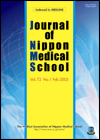89 巻, 5 号
選択された号の論文の15件中1~15を表示しています
- |<
- <
- 1
- >
- >|
Review
-
2022 年 89 巻 5 号 p. 470-478
発行日: 2022/10/25
公開日: 2022/11/09
PDF形式でダウンロード (152K)
Originals
-
2022 年 89 巻 5 号 p. 479-486
発行日: 2022/10/25
公開日: 2022/11/09
[早期公開] 公開日: 2022/05/30PDF形式でダウンロード (251K) -
2022 年 89 巻 5 号 p. 487-493
発行日: 2022/10/25
公開日: 2022/11/09
[早期公開] 公開日: 2022/05/30PDF形式でダウンロード (168K) -
2022 年 89 巻 5 号 p. 494-499
発行日: 2022/10/25
公開日: 2022/11/09
[早期公開] 公開日: 2022/05/30PDF形式でダウンロード (145K) -
2022 年 89 巻 5 号 p. 500-505
発行日: 2022/10/25
公開日: 2022/11/09
[早期公開] 公開日: 2022/05/30PDF形式でダウンロード (86K) -
2022 年 89 巻 5 号 p. 506-512
発行日: 2022/10/25
公開日: 2022/11/09
PDF形式でダウンロード (164K) -
2022 年 89 巻 5 号 p. 513-519
発行日: 2022/10/25
公開日: 2022/11/09
[早期公開] 公開日: 2022/05/30PDF形式でダウンロード (146K) -
2022 年 89 巻 5 号 p. 520-525
発行日: 2022/10/25
公開日: 2022/11/09
[早期公開] 公開日: 2022/05/30PDF形式でダウンロード (64K) -
2022 年 89 巻 5 号 p. 526-532
発行日: 2022/10/25
公開日: 2022/11/09
PDF形式でダウンロード (284K) -
2022 年 89 巻 5 号 p. 533-539
発行日: 2022/10/25
公開日: 2022/11/09
PDF形式でダウンロード (329K)
Case Reports
-
2022 年 89 巻 5 号 p. 540-545
発行日: 2022/10/25
公開日: 2022/11/09
[早期公開] 公開日: 2021/09/14PDF形式でダウンロード (838K) -
2022 年 89 巻 5 号 p. 546-549
発行日: 2022/10/25
公開日: 2022/11/09
[早期公開] 公開日: 2022/04/11PDF形式でダウンロード (634K) -
2022 年 89 巻 5 号 p. 550-554
発行日: 2022/10/25
公開日: 2022/11/09
[早期公開] 公開日: 2021/09/14PDF形式でダウンロード (666K) -
2022 年 89 巻 5 号 p. 555-561
発行日: 2022/10/25
公開日: 2022/11/09
[早期公開] 公開日: 2021/09/14PDF形式でダウンロード (990K) -
2022 年 89 巻 5 号 p. 562-567
発行日: 2022/10/25
公開日: 2022/11/09
[早期公開] 公開日: 2021/09/14PDF形式でダウンロード (729K)
- |<
- <
- 1
- >
- >|
